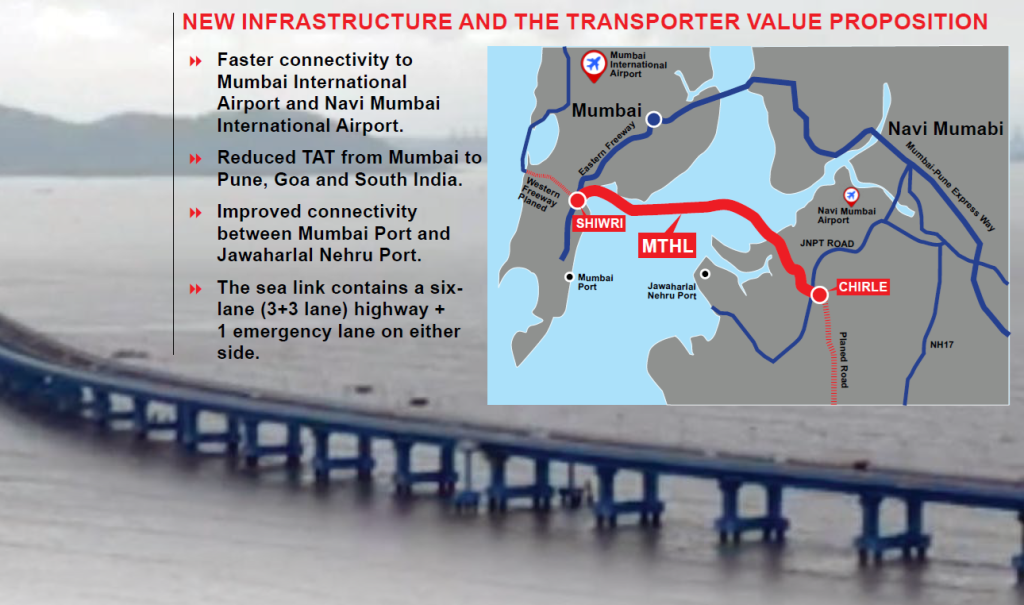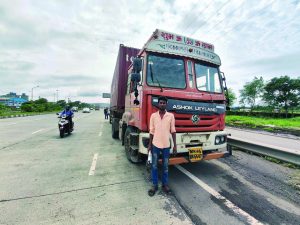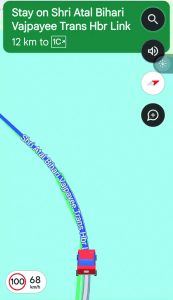The stress on fast-tracking infrastructure like India’s longest sea bridge has transporters leveraging a twin combination, finds Ashish Bhatia.
Pilot Umashankar Yadav has been in the tanker business of oil distribution to oil depots for further distribution to fuel stations for over two decades now. In a timid business environment, it is getting harder to make ends meet and sustain the business. From pulling off 15 tanker trips per day on the Mumbai-Delhi Mumbai-Chennai route down to two trips or worse nil trips per day and the tankers idling. The access to new infrastructure projects like the longest sea bridge in India has given a new ray of hope to transporters like Yadav. To save on nearly two-thirds of the Total Cost of Operations (TCO) for higher profitability through quicker Turn Around Times (TAT) on projects like the Atal Bihari Vajpayee Sewri Nhava Sheva Atal Setu – Mumbai Trans Harbour Link (MTHL).
Yadav and transporters like him are looking forward to the completion of other flagship projects like the Delhi-Mumbai corridor. Given Yadav’s assessment of the gains from accessible sections like the Vadodara to Bharuch stretch in combination with a capable commercial vehicle, the maths works out as a win-win, he grins! On the six-month anniversary of Atal Setu, CV Magazine set out to validate the gains for the transport business using the Atal Bihari Vajpayee Sewri-Nhava Sheva sea link! From January 13, 2024, to August 25, 2024, a total of 50,04,350 vehicles, including BEST, NMMT, MSRTC’s Shivneri buses, and various private and commercial vehicles, have traversed this vital link.
A crucial addition to the Mumbai Metropolitan Region’s landscape, the flagship project is known to have been built at a cost of about Rs 17,840 crore facilitated with direct borrowings from the JICA Official Development Assistance loan. At the start of 2024, it set the tone with public and private transporters hopeful of running more profitable and sustainable operations as they ply over the Mumbai harbour. Halfway through 2024, Commercial Vehicle Magazine set out on the occasion of the flagship project’s six-month anniversary milestone to verify the claims of the bridge making a significant impact on the transport business. As per MMRDA data made public, of the 11,07,606 vehicles that used the bridge between January 12 and April 23, nearly 10 per cent constituted Multi-Axle Vehicles (MAVs) and minibuses indicating a significant headroom for use by CVs.
Other reports peg the daily use of the seabridge by 22,000 vehicles compared to the carrying capacity of 70,000 per day pointing at a buffer that can be utilised to decongest the bottlenecks further. More recently, the call to upgrade the CCTV system on the system has also been voiced owing to traffic violations on the bridge since its inauguration not being captured as part of the ongoing upgrades to optimise the crucial connector.
While infrastructure is a crucial piece of the jigsaw puzzle, it is also true that the new block of infrastructure in the public transportation matrix requires Indian CVs and their Bharat Stage VI (BSVI) phase two RDE avatars to match up. The need of the hour is to prioritise the next generation of commercial vehicles deemed more capable in the eyes of not just the OEMs but the transporters running them for daily business on the new routes.
With his All India permit, pilot Shyam Mishal hails from Uttar Pradesh and has been driving since that time, the transport license cost Rs. 2400. Today he pays to the tune of 10,000 plus to keep it current. Having seen the transition from Bharat Stage III to Bharat Stage VI, from old routes to new ones like the Atal Setu. With a truckload of pharmaceutical powder, he drives 16 hours daily and is happy cruising from Sewri dock to JNPT port for the onward journey. Driving remains a tough profession and he has no choice but to surrender to on-road challenges like diesel theft in areas like Kalamboli in Navi Mumbai.
The Atal Setu and connecting infra in MMR have renewed transporter aspirations of the fleet upgrade as the missing pieces of infrastructure in the maximum city come together. There is a ray of hope for transporters. The marriage with the upgraded legacy Indian CVs like the Mahindra Bolero Pik-Up with the Bolero Maxx Pik-Up HD 2.0L offering a higher value proposition is one among such examples where transporters meet the performance ask of modern-day, concretised corridors offering a cruise run and demanding a bare benchmark of onroad worthiness.
The Mahindra Bolero Maxx Pik-Up builds on its rugged DNA with a renewed focus to maximise the transporter value. Coupled with new infra, it seems to be a win-win for the stakeholders! Testimony to this was when we drove from Sewri and past the Chirle exit when a group of drivers seeking shade from the afternoon sun took a long hard look at the new Maxx. Eager to get a touch and feel of the new Bolero Maxx, they did and the ‘CV Of The Year’ at the Apollo CV Awards 24 edition, impressed them in its latest avatar.
So much so that some of them called their operator friends in tier 2 cities to inform them more about the value propositions and consider an upgrade. Their calling card proved to be the rugged DNA powered by the m2Di four-cylinder, two-litre engine mated to a five-speed manual synchromesh transmission, the power steering and the huge 3050 mm x 1800 mm x 650 mm load tray. The certified D+2 seating capacity with a height-adjustable driver seat is covered with fast-cooling AC. Tested on the 21.8 km sea bridge, it made for a comfortable ride and proved to be a major attraction for this driver group. The heater and demystifier are a bonus. The 16-inch radials made for capable companions and impressed another section of the transporters. Vehicle tracking and iMaXX technology for relaxed and cost-efficient route planning with geo-fencing sweeten the deal. The ‘Fleet Dashboard’ displays key metric and Key Performance Indicators (KPIs)relating to various aspects of how an operator uses the Pik-Up. For night journeys, there are category first turn safe lights onboard. A service interval of 20,000 kms is reassuring for them and sets a benchmark for others to follow. This is just one example of Transporters including market load operators, willing to upgrade their existing fleets if the tangible propositions on performance, profitability, safety and comfort are in sight.
Now that the infrastructure is coming up to speed, nodal agencies like MMRDA as per MTHL Toll Rate Committee Member and Transportation Analyst, Sudhir Badami, continue to urge the stakeholders on measures to improve mobility. Among his suggestions shared with the CMO is i.e. He reiterates the National and State Urban Transport Policy of giving top priority to public transport. The math is that not only will the MTHL costs be recovered but will earn the exchequer a surplus too which in turn could be added to a fund that the government must create for meeting all the needs of prioritising public transport. The toll must be a reflection of the government policy to implement public transport projects as all stakeholders work towards a common goal of prioritising public transport and seamless connectivity.


























